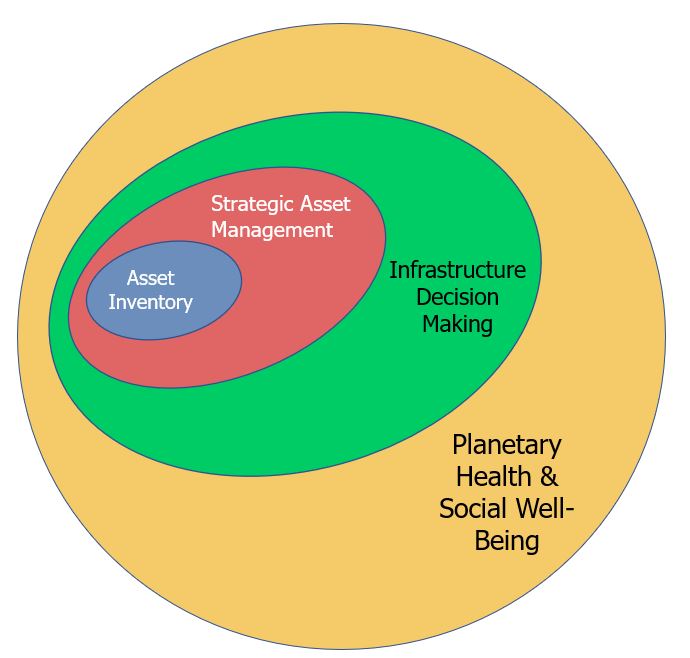
I work with a variety of organisations in several countries who are attempting to implement good Asset Management. Some are just starting out. A few are quite sophisticated. And one or two are even tackling the question of infrastructure decision making in our communities.
I was struck again this month by how hard this all sometimes seems.
Organizations who are just starting out have interesting challenges, of course, including no-one much understanding what AM is and, usually, a lack of resources. One half time resource without much authority, for example, can’t do much to radically transform their business.
But surely it doesn’t have to be that hard, conceptually, to sort out a basic asset inventory, classic Wave 1? Plenty of organisations have already sorted that – it is, as my old colleague John Lavan put it, a puzzle, for which there is an answer already known, not a problem we haven’t yet solved.
And yet many people just don’t seem to have good sense about asset information. And want to reduce the problem to basic IT, which they also don’t do very well. (I am feeling a bit grumpy about this: can’t someone please donate good-enough asset hierarchies and principles into the public domain, or even write the book so no-one ever has to reinvent those particular wheels? TJ, Dave Ulrich, I am looking at you guys here.)
Wave 2, strategic AM and better all-round asset decision-making also depends on something rather more than technology – and that, I am sure, is why organisations struggle. It involves people! Culture! And politics, small p, and sometimes Big P too!
Where Asset Management is effective, infrastructure Asset Managers can then get caught up in Wave 3. And however smart and well-resourced they are, it’s big.
A great current example is electric buses, something the US Federal government wants to throw money at as part of ‘decarbonization’ of transport. But the questions of how, and why, to invest with all the interconnecting issues of the infrastructure for the buses themselves, performance and customer satisfaction, and whether this will even give the right carbon-reduced answer…
Asset Managers get it. But they are a small drop in a large ocean of greed and love of shiny new things.
I asked a buddy who’s simply caught in too many stupid business decisions in a utility whether he might just bring in some additional resources to tackle more of them… But he said, quite rightly, where from? Who gets it, and all the diplomacy, strategic thinking, experience, intelligent use of what data there is that is that’s required, all at once?
ISO 55000 doesn’t help it all that much.
In a new series of blogs, I want to look with your input at some of the challenges we see in every Wave. Of course we love challenges. But I also see rather too many Asset Managers at every stage drowning in the sheer size of the job.
Series to include: asset information, risk, networking, attitude change, and more.
In May 2018, Penny Burns and Jeff Roorda wrote here about three ‘revolutions’ in Asset Management – later renamed ‘waves’, because that captures better the idea that one wave doesn’t supersede another.
Since then, we have discussed with each other and many others how Wave 1, ‘Asset Inventory’, is more successful if you already have in mind the vision of Wave 2, ‘Strategic Asset Management’ and how you are going to use all of the information you collect.
We have looked at what Asset Management practitioners need to develop to move on from this, to be able to look beyond our own organisations, to a bigger role in supporting our communities. We called this Wave 3, supporting better ‘Infrastructure Decision Making’.
We have even begun to imagine Wave 4.

As Penny puts it: whereas Wave 1 looked at WHAT we had, and Wave 2 looked at HOW we needed to manage it, Wave 3 started to ask WHO we were serving by our efforts. This has brought us now to start thinking more deeply about this question and about the next move, looking at the critical question of WHY.
As Asset Management practitioners, we have to ensure we are in the right positions of influence to be able to challenge existing infrastructure assumptions, which is what I think Wave 3 is all about. To look ‘up and out’, as Lou Cripps of RTD puts it.
But we can already spot that there is no point in being able to ask hard questions, if we don’t have the right questions to ask….
What do we mean by ‘better’?

Dreamstime.com/ 187958062 © Meg Forbes
The world of infrastructure Asset Management has had the benefit of an evolutionary model for several years: the ‘Waves’ of Penny Burns, to make sense of how organisations seem to have to go through a period of focus on basic information (Wave 1, Asset Inventory) before they really look at how to use it to make better decisions, to start optimising (Wave 2, Strategic Asset Management).
Before that, I confess, I struggled to express what was going on: how could people get stuck in data and databases? I don’t know that I fully understand, still, but I least I recognise it now – that having a list of all your assets, simple facts like install date and location, and a big dumb database to put it all in preoccupied so many of us for so long.
Penny herself seems not to have spent too much time worrying about this, but always had a vision way beyond it. She assumed we would have a grip on lifecycle costs, thinking longer term, and planning ahead, and get down to acting smarter on our asset decisions.
And now, as we work together to capture our collective history and development, we are really looking forward to the next Wave. To really so much better infrastructure decision making that is fit for purpose, through the rest of this turbulent century.
Look out for celebrating our history on July 29th!

Recent Comments